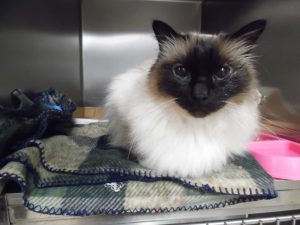You may have been advised at some point that your pet needs a ‘dental’.
But what does this mean? And why is it such a big deal?
Importance
Dental disease is a BIG problem. Similarly to in people, dental disease is inevitable without good oral hygiene. What starts off as a small amount of tartar, quickly progresses to gingivitis (gum inflammation) and severe periodontal disease – affecting the tooth roots and surrounding bone.
Dogs and cats show pain in very different ways to people. We regularly have pets with issues that we know are painful (e.g. tooth fractures, unstable teeth, abscesses) who still continue to eat well and appear ‘normal’. We also see plenty of dogs and cats that need very intensive dentals – multiple extractions, very long anesthetics (sometimes 2-3 hours), and end up with not many teeth at all.
Our aim is to help prevent dental disease. With good planning, home care and regular veterinary interventions, we can aim to keep our pet’s teeth healthy and comfortable – and in their mouth! – for many years.
Dental Exam
The first step is a thorough dental examination by your veterinarian. Here, we will identify the ‘grade’ of the dental disease – looking at the level of calculus (tartar) and gingivitis (gum inflammation). Ideally, we examine and perform dental procedures every 1-2 years to keep your pet’s teeth as healthy as possible. Sometimes this is not feasible, and your pet may already have more severe dental disease.

Bonnie wasn’t showing any signs of oral pain, but look at this ulceration to his cheek
as a result of tartar build-up on his upper molar tooth
Preventative Dentistry
A good preventative dental involves a full anesthetic, radiographs of all the teeth, probing to identify pocketing and instability in the teeth, extractions as needed and then a scale and polish. We record all findings on a specific dental chart, and x-rays are archived to compare at future dentals.

Here is Bonnie with his endotracheal tube, being monitored with a pulse oximeter and having his temperature maintained by a heat mat. At Dexter Animal Clinic, every patient also has an intra-operative ECG, intravenous fluids and continual monitoring by a trained technician.
Having your pet in for an anesthetic can be scary – but with thorough veterinary assessment before anesthesia, and modern medications and techniques, thankfully anesthetic complications are rare.
Here is Bonnie with his endotracheal tube, being monitored with a pulse oximeter and having his temperature maintained by a heat mat. At Dexter Animal Clinic, every patient also has an intra-operative ECG, intravenous fluids and continual monitoring by a trained technician.
Having your pet in for an anesthetic can be scary – but with thorough veterinary assessment before anesthesia, and modern medications and techniques, thankfully anesthetic complications are rare.
Dental radiographs (x-rays) help us to identify disease in the tooth roots significantly earlier than we would if we didn’t take x-rays. This means less pain for your pet, a shorter anesthetic and a less invasive dental procedure. For this reason, we take x-rays of every single tooth and the price is factored into your dental estimate.
Any extractions?
X-rays, as well as probing each tooth, help us decide which teeth are diseased, painful, or likely to progress to cause a problem in the near future. X-rays also help us decide which technique to use to extract a tooth, and to identify retained roots or other issues after extraction.
We regularly perform local anesthetic blocks on the major nerves of the jaw, both to keep your pet more stable under anesthetic and to improve post-operative pain.
Extractions are often surgical, involving removing a flap of gum and an area of bone over the tooth root. This technique is much less traumatic to the bone and soft tissue around the tooth roots than a ‘closed’ extraction technique. Your pet may have absorbable sutures placed to help the gum heal quickly after an extraction. Your pet is likely to come home with pain relief, and sometimes antibiotics, if extractions were needed. The mouth can be sore for a few days, but most pets do very well from 5-7 days after extraction. We have many patients with very few teeth who still crunch dry food with no problems!
Home Care
The best plan to minimize the amount of extractions needed and maintain your pet’s oral health is to combine regular preventative dentals (under anesthetic) with good oral home care:
Regular (ideally daily!) cleaning with an enzymatic toothpaste. The enzymes in the toothpaste help to reduce tartar, even if you are not able to fully brush all the teeth. Our clients who do this well have spent lots of time building up their pets confidence – first, let your pet lick the toothpaste off your finger and then slowly build up to using a toothbrush. Even cats can get used to this, especially if you start when they are kittens.
See this video from Virbac for tips on how to brush your pet’s teeth, or come and see one of our Veterinary Technicians: https://vimeo.com/virbac/review/103146944/fc676e4054
There are many products available to keep your pet’s teeth as healthy as possible – come and see us for some suggestions. The best source of information on what to buy is the Veterinary Oral Health Council. See VOHC.org for a list of dental specialist approved treats, foods and additives that can be added in to your pet’s diet. (Make sure you watch the calories you are adding and reduce other food types to prevent obesity!)
As always, check with your veterinarian if you have any questions or concerns about your pet’s oral health.

Bonnie recovered well from his anesthetic and is now enjoying plenty of his favorite poultry-flavored enzymatic toothpaste!


